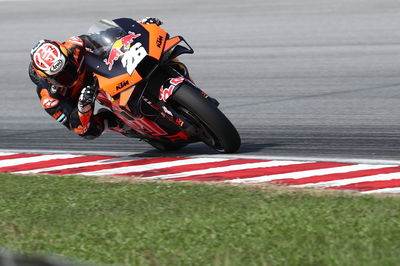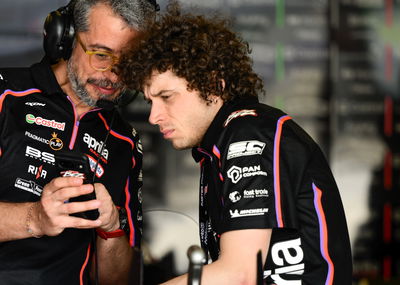Exclusive: Cancelled laps, DSQ for breaching MotoGP tyre pressures in 2023
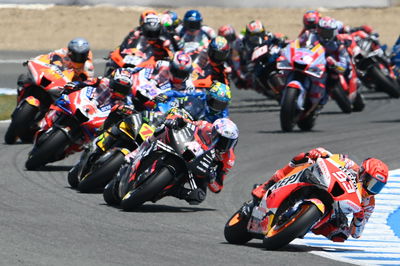
While the principle of remaining within the working pressure range provided by Michelin is unchanged, policing of the rules will become much more precise.
But because tyre pressure fluctuates when out on track, rising when following another rider for example, manufacturers have agreed to a level of tolerance before applying penalties.
In an interview with Crash.net, MotoGP Director of Technology Corrado Cecchinelli explained that in the case of practice and qualifying, this is likely to mean any rider that drops below the minimum tyre pressure for a certain amount of time loses that lap.
For a race, a breach will be determined by counting the number of laps when a rider’s average tyre pressure is above the minimum specified by Michelin, which is 1.9 bar for the front tyre and 1.7 for the rear.
“There will be clear pressure requirements for a timed lap to be accepted, or for race to be considered as compliant with the rules,” Cecchinelli told Crash.net.
“These requirements are still under discussion, but the concept is a lap is good if the tyre is above the minimum pressure for a specified amount of time during that lap.
“For a race, the concept is you calculate the average pressure over each lap and then the number of laps for which the average pressure was above the minimum.
"So the requirement might be, for instance, that the average pressure must be above the minimum for half of the number of race laps.
“I'm giving you rough numbers because it’s not decided. But we are considering something like: A certain amount of time above minimum pressure during a fast lap and a portion of the race distance above minimum pressure for the race.”
Practice and qualifying laps are already cancelled for passing a waved yellow flag or exceeding track limits, but teams will be given three races before the new pressure penalties are applied.
“There's a danger of seeing a lot of cancelled laps. So it's already been agreed that, although we are introducing the new system from the start of next season, we are not applying [penalties] until after at least three races,” Cecchinelli said.
“We are very open to taking the time needed to have it all working properly. It’s something we, as the organiser, are trying to do in the common interest of the manufacturers to provide them with fair racing conditions.
“It will be possible for teams to fit the full official tyre pressure system on their bikes at the pre-season tests next year, so they can start to understand it, then they can get real race weekend data during the first rounds.
“Our only interest is that everybody is happier with the new system than without it.”
The method described by Cecchinelli fits with the protocol shown on a leaked datasheet from this year’s Spanish MotoGP, which listed whether each rider's front and rear tyres had been ‘equal or above’ the minimum pressure for at least 12 of the 25 race laps.
With the new 'unified' tyre pressure system still under development at that stage, the sheet was only advisory since it consisted of pressure data ‘supplied voluntarily’ by each manufacturer from their own 'individually calibrated' sensors.
MotoGP Technical Director Danny Aldridge said the purpose of the list was for manufacturers to ‘evaluate’ the new 2023 tyre pressure protocol. As such, the 12-lap cut-off given further underlines that riders will probably need to be above the minimum pressure for around half a race distance to avoid disqualification next season.
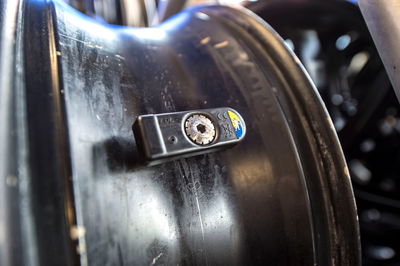
A Michelin tyre pressure sensor.
‘You could gain by going on the dangerous side’
Tyre pressures need to be monitored since operating below the minimum can offer performance benefits at the expense of safety.
The difficult part is agreeing on exactly how and when to monitor the pressures.
“The principle of the rule itself is not changing, which is you have to use the tyres in a working range that the supplier wants them to operate in for safety,” Cecchinelli confirmed.
“Given the rule, we now need to police it, as, in general, the safe pressure range may not be the best range for performance. That’s the unlucky side of the story!”
Interestingly, while teams believe running below the operating range can offer more performance, Michelin doesn’t necessarily agree.
“Temperature is also involved, but you may get a performance advantage by going lower than the recommended pressure,” Cecchinelli said.
“I'm saying ‘may’ because this is not necessarily what Michelin says, in which case teams that go under would not only be doing a dangerous thing but a stupid thing in terms of performance!
“But because teams are doing it, that tells me they have found something and, based on my experience - which is now old - they could gain by going on the dangerous [lower] side.”
Cecchinelli was Technical Director of the Ducati MotoGP team from 2003 to 2005, then Vice Director General of Ducati Corse until becoming MotoGP’s Director of Technology from 2011.
“There's a recommended range of tyre pressure and temperature that you should stay within, and this is not changing,” Cecchinelli emphasised. The difference is that, “next year we'll have a unified system in place that is able to measure in a secure way the pressure in real time.
“We [already] have a system in Moto2 and in MotoE, from which we took inspiration for some parts of the new MotoGP system. I'm not saying ‘new rule’ because actually the rule is not new, it's just a new way of enforcing it, by putting it in mathematical terms.
“Now we are saying that, to comply with the tyre manufacturer’s recommendations, you have to stay above the minimum pressure for a given time. We’re defining exactly what that means so there's no more arguments. It’s an application protocol, not a rule.”
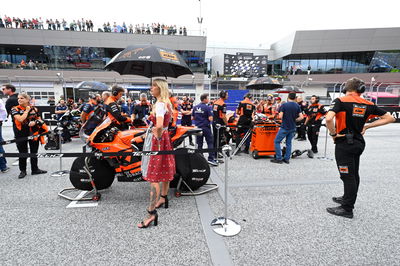
Why not just check tyre pressures on the grid?
The new system is undoubtedly impressive in technical terms, but what’s wrong with using a tyre gauge to check the pressure in the pits or on the grid?
“Please ask someone else! Because this is the way I recommended,” smiled Cecchinelli. “For me, there's a dangerous level of pressure that you should never go below and the enforcement of the rules should be as simple as, ‘we can check your tyre pressure at any time and it shall always be above minimum’. End of story.
“The problem in doing that - which I’m not convinced about, so I'm still in favour of keeping it simple - is that because tyre pressure rises on track, even when you are below the minimum in the pits or on the grid, you could be above the minimum for the flying lap or most of the race distance.
“So if you were to do the tyre pressure checks in the pits, maybe you would need to also lower the minimum pressure allowed from 1.9 to 1.2 bar for example [for the front tyre]. Not a big deal, to me, once the new number is agreed.
“I can tell you that some manufacturers would agree to this simple [in the pits] method. But to have an enforcement system that is accepted by all, you have to compromise and so we had to come up with a very complicated system.”
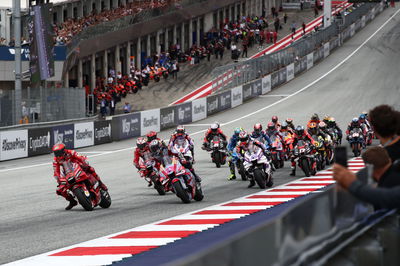
'You should care about pressure when the bike is moving'
Quizzed further on why some manufacturers resisted a simple tyre gauge system of spot checks, Cecchinelli added:
“There are objections like, ‘by measuring the tyre pressure with a gauge you are actually affecting the pressure itself’. Which to me is nonsense.
“Another objection raised is that ‘you shouldn’t care about my tyre pressure on the grid, you should care about my pressure when the bike is moving’.
“So one argument is you could heat the tyre to 200 degrees before going to the grid - assuming you are not destroying the tyre - then your pressure is above minimum for as long as anyone can check you.
“But once you start the race, the tyre cools and the pressure actually decreases instead of increases. So you might do the entire race with a pressure that is lower.
“Okay, so we could check pressure at the end of the race as well: ‘No! Because you could do the in-lap spinning the rear tyre to bring the temperature and pressure up again’. These are the arguments against our simple idea!
“So the new protocol for the implementation of the tyre pressure rule is very complicated.
“I can tell you it's a big project. You have to have an encrypted system, of course. And like with the flashing rear light [accident warning system] you have to move data from the bike, to the track, then to timekeeping, then back again.
“Because if the tyre pressure is too low, it's timekeeping that has to cancel the lap.”
